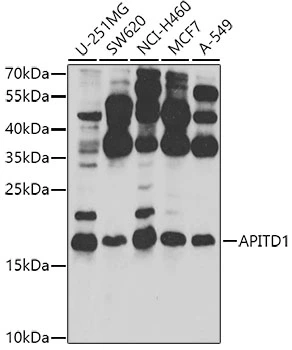
WB analysis of various sample lysates using GTX32452 APITD1 antibody. Dilution : 1:1000 Loading : 25microg per lane
APITD1 antibody
GTX32452
Overview
- SupplierGeneTex
- Product NameAPITD1 antibody
- Delivery Days Customer9
- Application Supplier NoteWB: 1:500 - 1:2000. *Optimal dilutions/concentrations should be determined by the researcher.Not tested in other applications.
- ApplicationsWestern Blot
- CertificationResearch Use Only
- ClonalityPolyclonal
- ConjugateUnconjugated
- Gene ID378708
- Target nameCENPS
- Target descriptioncentromere protein S
- Target synonymsAPITD1; apoptosis-inducing TAF9-like domain-containing protein 1; apoptosis-inducing, TAF9-like domain 1; CENP-S; centromere protein S; FAAP16; FANCM associated histone fold protein 1; FANCM-interacting histone fold protein 1; Fanconi anemia-associated polypeptide of 16 kDa; MHF1
- HostRabbit
- IsotypeIgG
- Protein IDQ8N2Z9
- Protein NameCentromere protein S
- Scientific DescriptionThis gene was identified in the neuroblastoma tumor suppressor candidate region on chromosome 1p36. It contains a TFIID-31 domain, similar to that found in TATA box-binding protein-associated factor, TAF(II)31, which is required for p53-mediated transcription activation. This gene was expressed at very low levels in neuroblastoma tumors, and was shown to reduce cell growth in neuroblastoma cells, suggesting that it may have a role in a cell death pathway. The protein is a component of multiple complexes, including the Fanconi anemia (FA) core complex, the APITD1/CENPS complex, and the CENPA-CAD (nucleosome distal) complex. Known functions include an involvement with chromatin associations of the FA core complex, and a role in the stable assembly of the outer kinetochore. Alternative splicing of this gene results in multiple transcript variants. Naturally occurring read-through transcripts also exist between this gene and the downstream cortistatin (CORT) gene, as represented in GeneID:100526739. An APITD1-related pseudogene has been identified on chromosome 7. [provided by RefSeq, Nov 2010]
- Storage Instruction-20°C or -80°C,2°C to 8°C
- UNSPSC12352203

